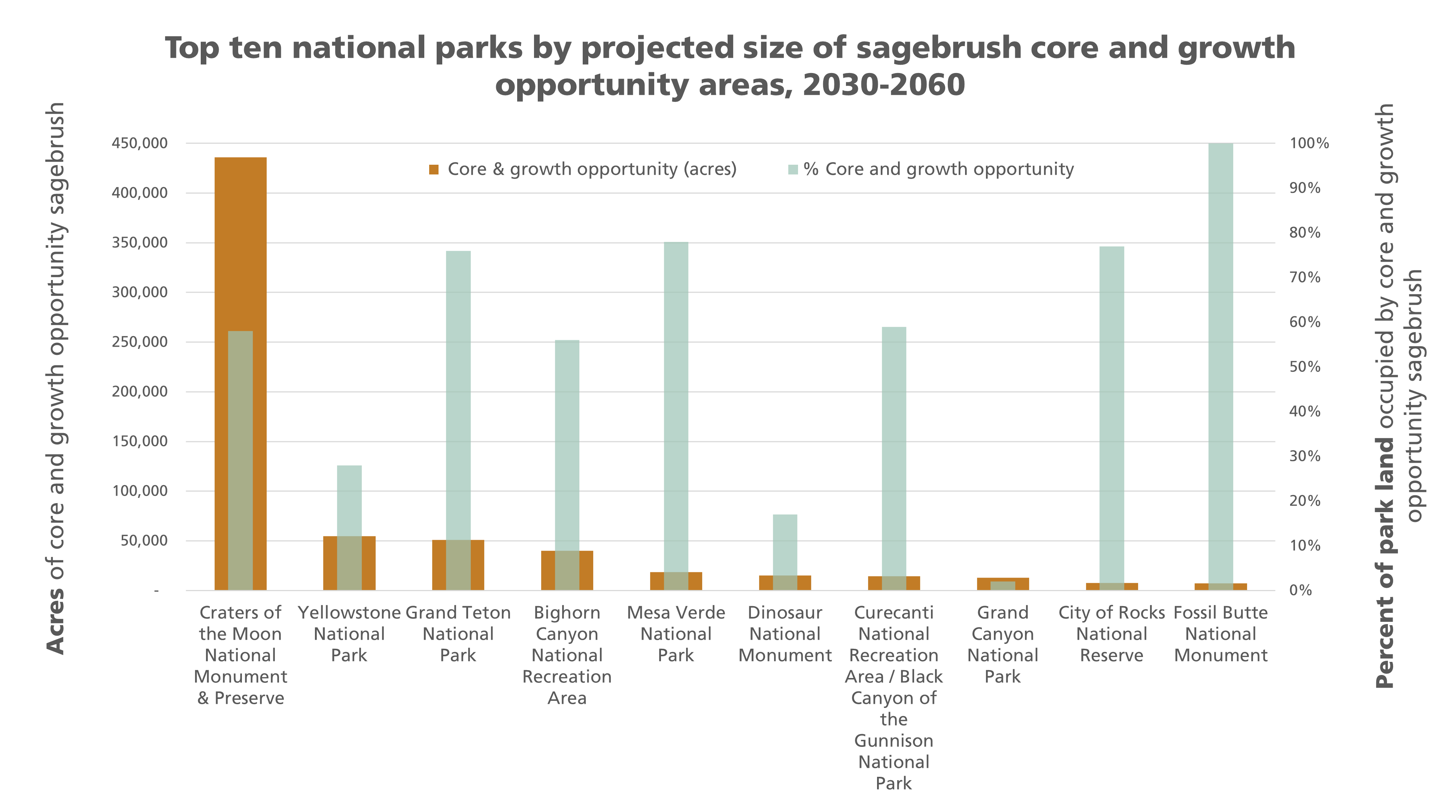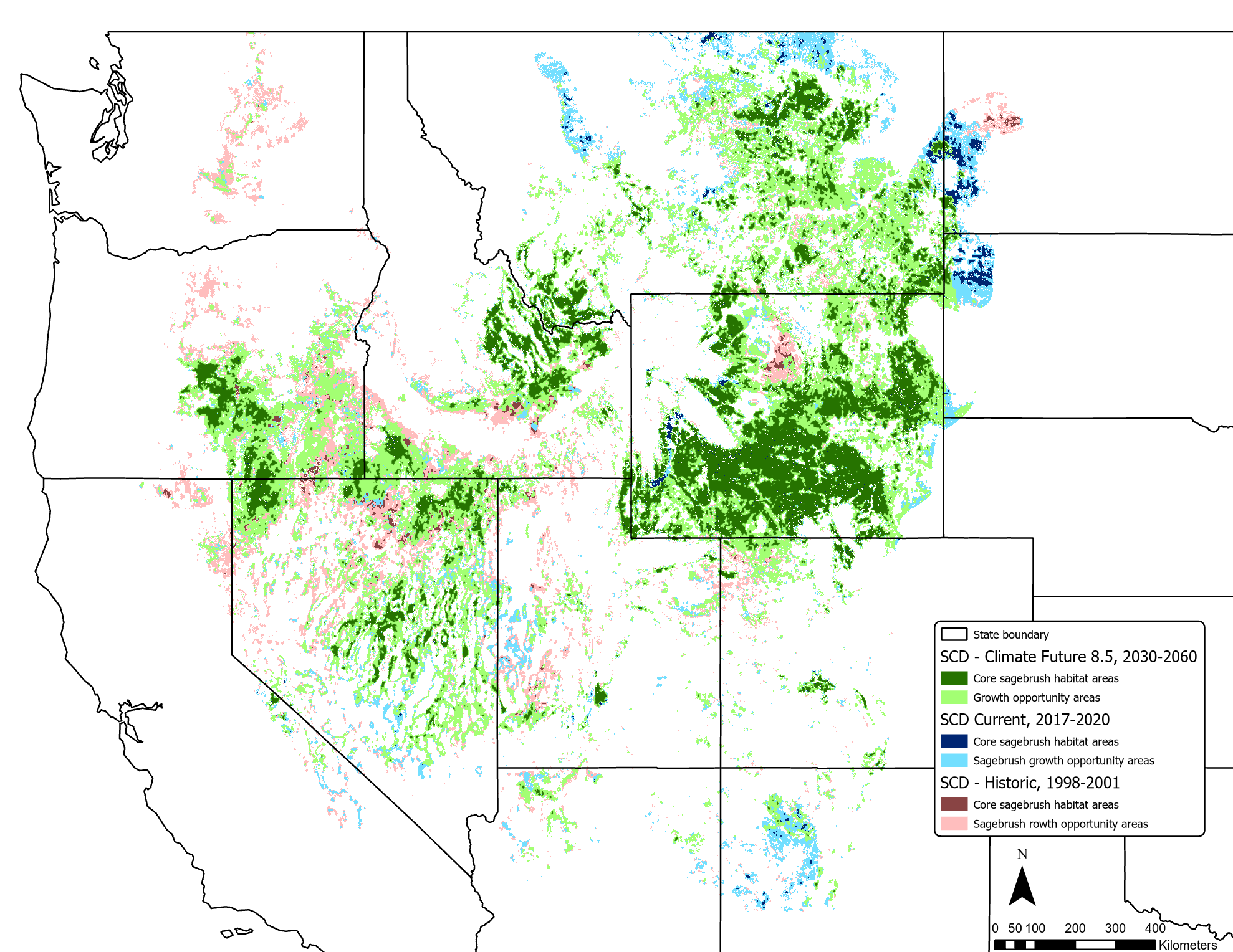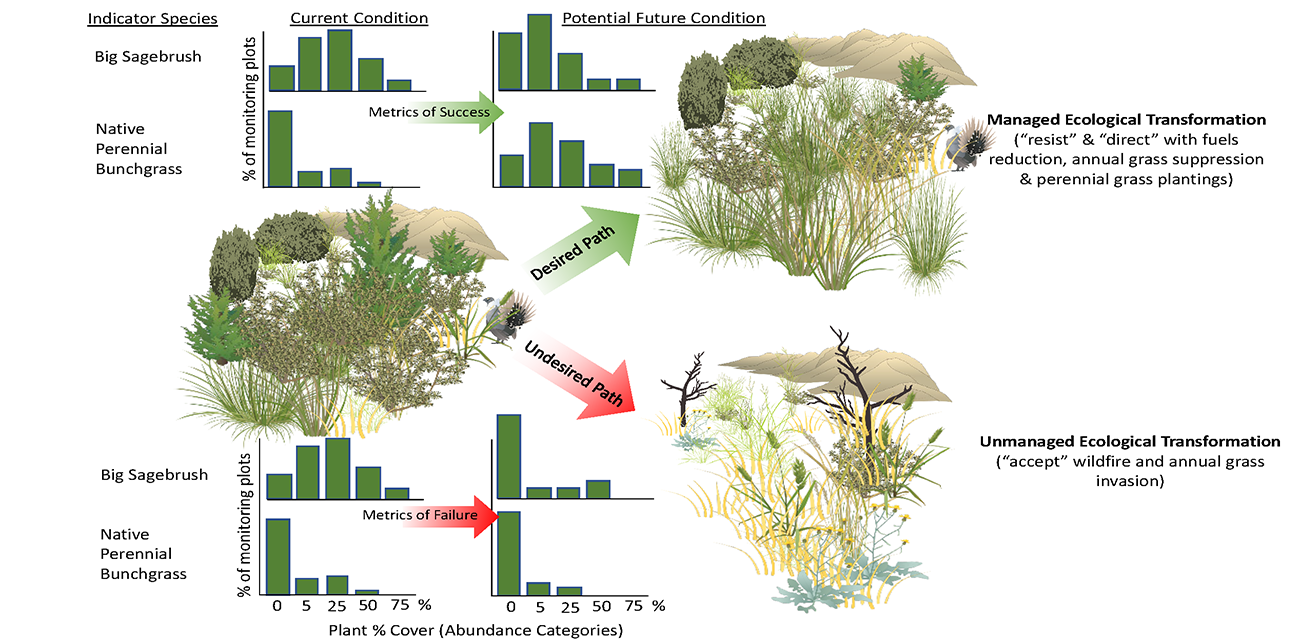Last updated: August 31, 2024
Article
Saving the Heart of the American West’s Largest Landscape
Sagebrush, America’s most imperiled ecosystem, is half of what it once was. Aided by recent infrastructure funding, a dedicated community of scientists is racing to protect the best of what’s left.
By Thomas J. Rodhouse, Jeff Lonneker, and Jordan Spaak

Image credit: Bureau of Land Management / Bob Wick
Often featured in classic western films, sagebrush landscapes are a fundamental part of the “big sky” country of the western U.S.
The foundational, namesake shrub of this ecosystem is covered with fine silver hairs that give it a subtle blue-green-gray color. Sagebrush grows in a vast region nearly 200 million acres in size across 13 western states. Dry but not quite true desert, sagebrush ecosystems are characterized by a suite of shrub species and a dizzying array of wildflowers and bunchgrasses. They flank the lower slopes of snow-capped mountains and stretch across valley basins. In total, sagebrush comprises the largest contiguous landscape in the U.S., occupying one-third of the lower 48 states. Sagebrush country is the connective tissue between forests and rivers through which, for eons, people, bison, elk, and mule deer have traveled.
Since time immemorial, Indigenous people have made their homes in sagebrush landscapes, raising children and grandchildren, thriving amidst spectacular biodiversity. In addition to game animals, dozens of sagebrush plant species remain important to tribal communities throughout the west for food and materials. Similarly, it was the richness of resources like the deep-rooted bunchgrasses as livestock forage that drew colonial settlers to the area and partly led to the creation of large cities like Boise, Reno, and Salt Lake City. Today, sagebrush lands continue to provide vital ecosystem services like storing carbon and water, regulating stream flow, and promoting pollinator diversity. They’re also critical habitat for over 350 species of plants and animals, including the spectacular greater sage grouse, pronghorn antelope, pygmy rabbit (the smallest on the planet), and many songbirds.
But because of human development, the sagebrush biome—as scientists call these areas—is now one of the most imperiled landscapes in North America, occupying only 50 percent of its historic range. It faces an existential crisis from an accelerating cycle of weed invasion, wildfire, and drought, threatening the very fabric of the western landscape. Hemmed in from all sides by conversion to farmlands, energy production, and urbanization, the remaining intact sagebrush—the “core” of this imperiled ecosystem—is found in only about 13 percent of the biome, concentrated in remote areas of Idaho, Montana, Nevada, Oregon, and Wyoming. Because it’s impossible to save all sagebrush lands in U.S. national parks, the National Park Service and its partners, with the help of recent federal funding, are focusing on protecting and growing core habitat in those park units where it exists.

Image credit: NPS / Wallace Keck
Varying Impacts from Climate Change
Dryland ecosystems like the sagebrush biome are vulnerable to climate change. But climate predictions specific to those landscapes offer reason for some optimism. According to recently published models, sustaining many of the core sagebrush areas may still be feasible for at least the next several decades, although researchers continue to study this. Scientific consensus suggests relative climate stability in many core areas for sagebrush landscapes. There are exceptions in the drier southern portions of the biome and on the northeastern margins of short-grass prairie, where bigger vegetation shifts due to climate change are more likely. In parks like Theodore Roosevelt National Park in North Dakota and Lake Mead National Recreation Area in Nevada, managers are thus faced with accepting rather than resisting climate-driven losses of sagebrush.
The National Park Service and its partners are using satellite-derived maps and a conservation strategy to protect and grow core sagebrush habitat.
But in much of the remaining biome, in places like Craters of the Moon National Monument and Preserve in Idaho, Grand Teton National Park in Wyoming, and the Gunnison Basin of Central Colorado, there are fewer direct climate impacts. Managers of parks and other public lands in those regions are grappling with how best to save their portions of the “sagebrush sea” (another term for the biome). It’s in places like these that the National Park Service and its partners are using satellite-derived maps of rangeland condition (collectively called the Sagebrush Conservation Design) and a conservation strategy to protect and grow core sagebrush habitat. They’re aided by an infusion of funds from the recently enacted Bipartisan Infrastructure Law and the Inflation Reduction Act.
A Natural Phenomenon, Now More Destructive
Although fires have occurred in sagebrush for millennia, the introduction of non-native cheatgrass, an annual plant, to the sagebrush ecosystem has fueled a destructive cycle of wildfire followed by further cheatgrass incursion. The extreme drought and precipitation caused by climate change exacerbate this cycle. Unusually cool and wet springtime weather causes cheatgrass to thrive. When this is followed by extreme heat and drought, the cheatgrass dries out and becomes fuel for fire to spread rapidly through sagebrush. Many scientists agree that saving the sagebrush biome thus hinges on our ability to interrupt this cycle of invasive grass incursion and wildfire.

Image credit: NPS

Left image
A cheatgrass-invaded sagebrush steppe site in the Clarno Unit of the John Day Fossil Beds National Monument in 1987.
Credit: NPS
Right image
The same Clarno site in 2012 after a series of wildfires. Note the complete loss of sagebrush shrubs and perennial bunchgrasses, replaced by cheatgrass and other weedy, non-native plants.
Credit: NPS
A Sobering Perspective
Because the scale of the sagebrush biome is so large and the cost of saving it so prohibitive, scientists have developed tools like the Sagebrush Conservation Design to help them focus on the most effective actions. Maps of core and growth-opportunity areas show where to carry out protective measures or accept losses and pursue alternative ones. Though we still need input from experts on the ground, Tom Remington, project coordinator of the sagebrush conservation strategy, said the maps provide a “sobering perspective on just how focused we need to be.” He added, “We are orders of magnitude short on the cash and capacity to defend all of the core across the biome, even with the influx of infrastructure funding. But we know we can win in more than a few places if we are focused and committed.”
More than 95 percent of all mapped core and growth opportunity areas are in only 10 parks and 10 refuges.
More than 95 percent of all mapped core and growth opportunity areas are in only 10 parks and 10 refuges. Bill Sparklin, a U.S. Fish and Wildlife Service invasive plant specialist who’s deeply involved in sagebrush conservation said these are “our best bets” for making conservation commitments. “This list puts an awfully bright light on these areas, at least for sagebrush,” Sparklin said, though he acknowledged there are many good reasons to invest in other units.

Image credit: NPS / J. W. McClosky. Data from Sagebrush Conservation Design.
| Park name | Core & growth (acres) | Percent core and growth |
|---|---|---|
| Craters of the Moon National Monument & Preserve | 436,084 | 58 |
| Yellowstone National Park | 54,538 | 28 |
| Grand Teton National Park | 50,835 | 76 |
| Bighorn Canyon National Recreation Area | 39,776 | 56 |
| Mesa Verde National Park | 18,529 | 78 |
| Dinosaur National Monument | 14,931 | 17 |
| Curecanti National Recreation Area / Black Canon of the Gunnison National Park | 14,445 | 59 |
| Grand Canyon National Park | 12,960 | 2 |
| City of Rocks National Reserve | 7,662 | 77 |
| Fossil Butte National Monument | 7,297 | 100 |
Identifying the Best
The Sagebrush Conservation Design uses estimates of land cover (vegetation) generated from earth images collected by orbiting satellites to identify areas with the most ecological integrity. The images show where sagebrush and perennial grass, or annual grass and conifer, predominate. They also show human modifications. Each pixel of the images represents 30 by 30 meters (100 by 100 feet). Although imprecise when applied to local park landscapes, this degree of detail is very useful across the entire 13-state biome.

Image credit: NPS
“The [design’s] main value is its ability to identify the best sagebrush areas and relative level of threats to those core areas,” Remington said, “giving us an unprecedented ability to identify where and how to move resources around and to set conservation goals and evaluate progress…We have not previously had a metric that could be used to evaluate progress towards collective goals at such a broad [geographic] scale.”
It’s a powerful example of science in the service of sound decision-making.
The Sagebrush Conservation Design has become a tremendous catalyst for collaboration. Sagebrush conservation scientists and land managers have rallied around the design, acknowledging its model-based limitations but using it to move the conservation needle rapidly forward. It’s a powerful example of science in the service of sound decision-making. The 2024 Society of Range Management annual meeting dedicated a day to understanding and applying the design. The Department of the Interior has used the design to identify places to direct federal infrastructure investments.
Fire in the Core
One of those places is Craters of the Moon National Monument and Preserve, on the edge of the Snake River Plain in Southeastern Idaho. This 700,000-acre park contains more core and growth-opportunity lands than all the other top 10 parks combined. Much of the low-elevation portions of the preserve are overrun with cheatgrass. But the higher northern portions at about 6,000 feet contain thousands of acres of intact sagebrush steppe. Many of these are in unique islands of vegetation surrounded by geologically recent ( from eruptions about 2,500 years ago) lava flows.

Image credit: NPS
The design maps show that the core and growth-opportunity areas in Craters of the Moon are bisected by a highway that exposes these areas to wildfires caused by malfunctioning vehicles. In fact, this has caused several recent fires, including a one-acre ignition during the writing of this article. The National Park Service and interagency partners are focusing on reducing cheatgrass along the highway corridor and other protection tactics. Craters of the Moon superintendent Wade Vagias underscored his interest in this strategy as “smart business.” But he said, “I want to see some accountability, a demonstration of success and return on investment through monitoring. This park is so big that it is too easy to get carried away on weed problems that are frankly unwinnable.”
Fuel reduction projects like this help to "starve" fires, preventing them from spreading into sagebrush.
The fundamental task is to check the spread of annual grasses to reduce wildfire risk. Through mowing and herbicide applications, the park is creating roadside fire breaks that reduce fuels, including cheatgrass, to give firefighters defensible corridors. Fuel reduction projects like this help to “starve” fires, preventing them from spreading into sagebrush. To support this, scientists are mapping fuel loads and developing fire-risk simulations to show where these tactics are most likely to be effective. Ongoing monitoring through the National Park Service’s Inventory and Monitoring Program will help address the efficacy of these actions and answer Superintendent Vagias’s concerns.

Image credit: NPS
This image shows two paths that current sagebrush areas can take in terms of the number of sagebrush monitoring plots with percent cover of big sagebrush and native perennial bunchgrasses.
Current conditions
On the left are column graphs of current conditions for each plant type, paired with an illustration representing most current sagebrush monitoring plots. The column graph for big sagebrush shows that most plots—the taller columns—fall into the five, 25, and 50 percent cover categories for this species. The column graph for perennial bunchgrasses shows that most plots feature zero percent of this species, while just a few have five or 25 percent cover or more. The illustration reflects these metrics. It is full of big, dense shrubs, with a few bunchgrasses and a few yellowed annual grasses. There is a greater sage-grouse among the vegetation.
Desired path
An arrow that reads "Metrics of success" points towards a similar pair of charts and an arrow that reads "Desired path" points towards an accompanying illustration on the top right for a potential future condition achieved via a "Managed ecological transformation. ('resist' and 'direct' with fuels reduction, annual grass suppression, & perennial grass plantings)."
- The column graph for big sagebrush shows that most plots would have lower cover of this species, especially around five percent.
- The column graph for perennial bunchgrasses shows that most plots would feature much more cover—with the biggest columns being for five and 25 percent cover—of these plants.
- The illustration reflects this change. It features fewer big sagebrush shrubs with a lot more bunchgrasses in between, still with a few annual grasses. A greater sage-grouse remains among the vegetation.
Undesired path
An arrow that reads "Metrics of failure" points towards a similar pair of charts and an arrow that reads "Undesired path" points towards an accompanying illustration on the lower right for a potential future condition achieved via an "Unmanaged ecological transformation. ('accept' wildfire and annual grass invasion)."
- The column graph for big sagebrush shows that most plots would have zero percent cover of this species.
- The column graph for perennial bunchgrasses also shows that most plots would feature zero percent cover of these plants.
- The illustration reflects this undesirable state. It features the charred remains of big sagebrush shrubs with a lot more weeds and yellowed invasive annual grasses in between. Notably, there is no greater sage-grouse in this image.
Seeding Innovation
Another core tactic is to increase the quality and amount of other types of native vegetation in sagebrush habitat. This is particularly important in the understory beneath the sagebrush shrubs, where healthy amounts of bunchgrasses and native wildflowers can compete against weed incursions, providing greater invasion resistance and fire resiliency. City of Rocks National Reserve, for example, is removing juniper trees that have shaded out native grasses and wildflowers.
To accelerate the recovery of this sagebrush understory vegetation, researchers are collecting native plant seeds and growing native plants. These can be planted immediately after ground disturbances like juniper tree removal or herbicide treatment, before weeds have the chance to take over the bare ground that is exposed. There’s been substantial infrastructure investment in this kind of proactive native plant seed collection and propagation. Parks and partners like Oregon State University-Cascades are supporting this work by rapidly expanding our capacity to obtain native plant materials.

Image credit: TandemLens.org / Mark Hewes
Native plant propagation is one topic where creative thinking has particularly taken hold. Plant geneticists and restoration practitioners are trying to move hardier, drought-tolerant types of bunchgrass species upslope. Several sagebrush parks, including Craters of the Moon, City of Rocks, and Great Basin National Park recently participated in an experiment to test whether native bunchgrass seeds coated with a protective layer of activated charcoal would survive when planted during herbicide suppression of cheatgrass.
"We will have to get into the game at some point. It’s just a matter of finding a comfortable pace of implementation that [keeps us from falling behind] the pace of ecological change."
Regarding these innovative experiments, National Park Service restoration biologist Katie Vinzant said, “We will have to get into the game at some point. It’s just a matter of finding a comfortable pace of implementation that [keeps us from falling behind] the pace of ecological change.” Vinzant is leading the agency’s participation in the National Seed Strategy. She’s a widely recognized expert on the topic of native seed collection and propagation. Having a supply of native plant material is a central part of the “defend and grow” strategy. Vinzant’s work, aided by infrastructure funding, has become integral to achieving the department’s sagebrush conservation goals.
Broad Benefits
Across the National Park System and around the globe, protected areas are coming to grips with change and uncertainties that prior generations would likely not have recognized. The accelerated weed and fire cycle across the vast sagebrush biome, and its potential national repercussions, is one of them. There are over 70 National Park Service units in the sagebrush biome. Although only about 10 of them are slated for major conservation investments, dozens more face the same challenges. But with common problems come common solutions. All sagebrush parks thus stand to benefit from the collaborative investments and collective learning happening throughout the biome, now supercharged by infrastructure funding.
About the authors



Tags
- black canyon of the gunnison national park
- city of rocks national reserve
- craters of the moon national monument & preserve
- curecanti national recreation area
- grand teton national park
- john day fossil beds national monument
- sagebrush
- sagebrush steppe
- fuels reduction
- habitat restoration
- partnerships
- bil
- bipartisan infrastructure law
- ira
- inflation reduction act
- landscape conservation
- npsage
- tom rodhouse
- jeff lonneker
- jordan spaak
- shrublands
- features
- ps v38 n1
- park science magazine
- park science journal
